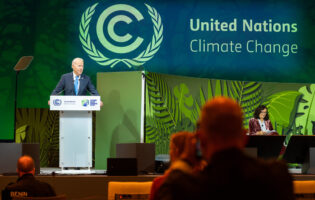Energiewende Fail?
Jamie Jarmon
Jamie Jarmon is a spring 2014 AICGS intern and is responsible for writing the AICGS Notizen Daily, assisting with the contact database, summarizing AICGS events, and contributing to the AICGS Notizen Blog. She also works closely with AICGS Society, Culture & Politics Program Director Lily Gardner Feldman on program research and projects.
Currently, Ms. Jarmon is enrolled as a full-time student at the University of Maryland, where she is seeking a BA in Central European, Russian, and Eurasian Studies, with a minor in public leadership, and a certificate in the University of Maryland’s prestigious Rawlings Undergraduate Leadership Fellows Program. She has three years of exposure to the German language, literature, and culture through her university, studying abroad at the Universität Tübingen, and working as an Au Pair in northern Germany. After Ms. Jarmon graduates, she plans to pursue a career in foreign relations.
In response to the 1986 Chernobyl nuclear disaster and the more recent 2011 catastrophe in Fukushima, Japan, Germany announced in 2011 that it would move quickly into using more renewable energy, hoping to phase out or significantly reduce hazardous non-renewable energy sources by 2022. Germany’s proposed initiative, the Energiewende or energy transition, is nothing new to the German people. Calls for a change in energy policy been around since the anti-nuclear movements of the 1970s, and the policy was officially termed “Energiewende” in 1980.
However, now this transition seems to fall short in its plan for renewables by introducing more lignite, or brown coal mining, into the German energy mix. Coal mining has increased as a way to compensate for the decrease in nuclear energy, creating additional environmental risks. Although coal is a cost-effective energy source, it can be argued that mining poses a threat to German villages, citizens, and overall climate change equal to that of nuclear power plants. It is understood that nuclear power can be hazardous if safety regulations are not followed; however, coal mining is just as dangerous as it equally puts the environment, citizens, and historical landmarks in danger. Evidence of these risks can be found in West Virginia, where the coal mining industry has long been active, despite mining accidents, destruction of the landscape, and dangers to the population—including the recent chemical spill that contaminated the water supply for 300,000 people. By looking at the impact of coal mining on West Virginia, one can see the danger Germany faces if it continues to increase its coal usage.
Why Coal?
Coal is the most affordable and convenient means for powering homes and businesses in both Germany and the United States. According to RWE AG, coal is Germany’s main gross power generator and energy producer, but the coal industry is also Germany’s second-largest consumer of electricity. In addition to Germany’s dependence on coal, the U.S. National Mining Association stated that, at 40 percent, coal mining is the most abundant, reliable, and affordable source of American electricity. When referring to coal mining, there are two main types of coal that Germany and the United States use, each offering different costs and benefits. Lignite a very soft and immature coal compared to other coal deposits, and it produces the lowest levels of energy while emitting some of the highest levels of air pollution. Germany produces roughly 23 percent of its energy from lignite coal, while the United States only produces around 7 percent. Bituminous coal is more mature and produces a higher energy rate, while emitting lesser levels of air pollution—this is the U.S.’ main source of coal. In Germany, RWE produces about 100 million tons of lignite coal each year .
Coal mining tends to bring the overall electricity cost down for consumers in both countries. In the U.S., electricity costs are down 30 percent for states who rely primarily on coal. The same can be said for Germany: “Rising coal supply and lower costs increased margins for European utilities burning the fuel. The price of coal for delivery to northwest Europe in 2014 fell 19 percent to $82.40 a metric ton last year.”
Finally, proponents of coal tout its job creation potential. At RWE in Germany, around 42,000 jobs have been created, producing approximately $8.1 billion in production value and $3 billion in employer wages. In the U.S., the coal industry is responsible for creating 204,580 jobs in 2011 alone, producing $40 billion dollars in coal sales and $18 billion dollars in direct wages. Coal mining is advantageous because of its high profit turnout, job creation, and abundance as a quick source for energy, but at what cost to the residents in close proximity to coal mines?
Problems with Coal Mining in Germany and in West Virginia
In general, coal can pose huge environmental and health problems, including soil erosion, dust, water pollution, lung damage due to nitrogen gas, mercury poisoning through contaminated fish, toxic sulfur dioxide gas, and carbon dioxide and methane emissions. Der Spiegel reported an all-time high in carbon dioxide emissions in Germany due to the rapid increase in lignite mining and the inexpensive cost of carbon dioxide emission permits. In the United States, these environmental hazards are causing problems for residents.
Germany
As a result of phasing-out nuclear energy, demand for lignite mining has grown in Germany; it now produces more lignite coal than in the past twenty years. This increase in lignite production is causing some concerns for German locals and is making waves in the American press. Two recent articles in the New York Times referenced Atterwasch, population 241, which dates to the fourteenth century and is facing relocation due to lignite mining. Vattenfall set up a coal mining site in nearby Jänschwalde, and is looking to expand its mining site to Atterwasch. The Swedish coal mining company, which already produces around 40,000 tons of coal per day, has applied to mine the coal underneath Atterwasch, which would ultimately displace residents by 2015 if state officials approve of the expansion. Previous mining expansions have been permitted, provided that the mining industry work out compensation deals with the residents. However, if state officials of Brandenburg deny the expansion, the mining plant will close and the region’s economy could suffer; if officials approve, people will lose their homes, and the area will lose cultural heritage, such as a medieval church, historic bells dating to before Christopher Columbus, and a cemetery with a special section devoted to German soldiers. Can compensation money replace lost history and precious mementos? Residents say no, and are ready to take a stand against the expansion.
United States
There is no surprise that in the United States, coal industries have posed health issues for their nearby neighbors and the overall destruction of the surrounding environment. Coal mining in the mountainous regions of West Virginia caused more than 1.4 million acres of forest and 2,000 miles of streams to be erased.¹ Further, drinking water in the area has become polluted and unsafe to drink. Recently, in January 2014, there was a widespread water contamination scandal in which the coal industry was the main cause. The water from nine counties was contaminated with 4-methylcyclohexane methanol, a chemical used to wash coal, causing officials to caution that citizens should not use the water except for “flushing the toilet.” Over 300,000 people were affected by this recent contamination problem. In 2008, Lindytown, West Virginia was relieved/evicted of all of its residents except for one family—adding to the many other towns that have disappeared because of coal mining expansion. The coal companies have tended to buy out every resident in order to procure the land for themselves—much like what Germany is planning with residents in Atterwasch.
Is It Really Worth It?Although there are clear reasons for Germany to continue its push forward for more lignite expansion, there are obvious concerns for its residents and the environment. When looking at the effects of coal mining in West Virginia, it’s hard to imagine that the coal mining companies such as Vattenfall and RWE are unaware of the dangers. Both Vattenfall and RWE claim that they are using better techniques to lower the chances of emitting too many greenhouse gases; however, they are not considering the many German residents’ lives and the history they are destroying. Therefore, Germany’s Ministry for Environment, Nature, Conservation and Nuclear Safety (BMU) and the Ministry of Economics and Technology (BMWI) need to reconsider the approach to reaching their goal of a renewable and clear energy source by 2022. When weighing the pros and cons, there seems to be more cons for the citizens than there are for the mining companies. Although coal is more cost effective, the amount of destruction coal mining causes to the environment is not worth it. Moreover, the coal industry creates jobs and revenue for both Germany and the United States, but at the cost of individuals’ health and communities. Furthermore, the amount of carbon dioxide, nitrogen, sulfur dioxide gas, and methane emissions is dangerous for the ozone layer, but also to humans who are exposed. Since coal is an abundant fossil fuel in Germany and in the United States, it is only natural to assume that coal would be the best way to continue to provide affordable energy, even if it is momentarily. However, when families are being displaced in Germany and in the U.S., and the environment surrounding these victims is being destroyed, could there not be a better way to provide safe and fair energy to everyone? If not, Germany may find itself with contamination issues just like its allies in the U.S., which would place Germany in an even worse predicament than where it currently stands with nuclear energy.
Endnotes:
- Steve Hawk, “The Cost of Coal,” Sierra, Vol. 97 Issue 6 (Nov/Dec 2012): 24-41.








